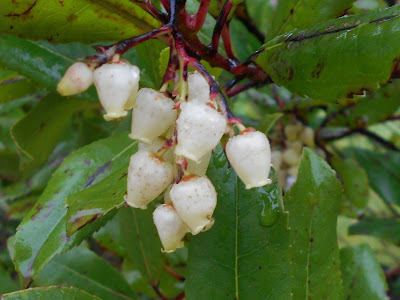Arbutus unedo is sometimes referred to as the Killarney Strawberry Tree for it is found wild in that county and adjacent ones in the Irish Republic. Along with about fourteen other species it forms the 'Lusitanian' element in the flora of the British Isles. Other plants in this curious group include St Patrick's Cabbage, Saxifraga spathularis, the Irish Fleabane, Inula salicina and St Dabeoc's Heath, Daboecia cantabrica (Note 1).
There is a Lusitanian fauna too. The Kerry Spotted Slug, Geomalacus maculosus and the Pyrenean Glass Snail, Semilimax pyrenaicus, are joined by a woodlouse, Oritoniscus flavus and all may share a similar history.
 |
| Arbutus unedo in flower. Church Street, Byfield. 18 October, 2017 |
But what is this history? All are found in parts - mainly the south-west - of Ireland and also in the Iberian peninsula (Lusitania was a Roman province roughly equating to modern Portugal), so there appears to be some kind of geographical linkage.
Fanciful theories once posited the existence of a lost land region, Atlantis, which existed somewhere to the west between Iberia and Ireland, thus resurrecting an idea which first appeared in the works of Plato. A more plausible theory concerns the situation which prevailed during the last stages of the Pleistocene. As the last ice sheets receded some fifteen thousand years ago land areas would probably have been exposed, the sea level being about 100 metres below the current level. Such land could form a bridge, thus providing a means by which certain organisms made the Iberia-Ireland journey. An alternative explanation could be a relatively mundane one: Mesolithic sea-going human travellers may have inadvertently carried these organisms as 'stowaways' and there is accumulating evidence to support this.
It might have been hoped that advances in genetics would have shed light on the subject. In fact these researches seem to have complicated the situation [Ref 1] and to outline the problems would cause me to digress too much from the main subject of this blog - the Strawberry Tree. Incidentally the genus should be pronounced ar'butus and not ar'but'us.
 |
The Church Street specimen appears to be bearing only one fruit.
18 October, 2017
|
Despite being confined in the wild to south-west Ireland and Mediterranean regions Arbutus unedo is reasonably hardy, surviving certainly in southern England and Wales and even becoming naturalised here and there. The flowers and extremely insipid fruit (unedo : eat once) are produced simultaneously in the autumn months. A vivid imagination may detect a resemblance between the rather warty fruits and a strawberry, but in appearance only, not flavour! It belongs to the Heather Family, Ericaceae, generally a lime-avoiding assemblage of plants, but whenever I have found the species wild in Spain, Portugal, France and Italy, it has been on distinctly limy soils. The fruits of the strawberry tree may ferment before falling, leading to stories of animals becoming drunk when feeding on them. Indeed even bears were believed to become intoxicated and the city of Madrid's coat of arms depicts a bear climbing a strawberry tree.
 |
Our own specimen, planted about six months ago, is about to come
into flower. 18 October, 2017
|
I said there are three Old World species. Arbutus andrachne is the Grecian member of the trio. It is a beautiful tree with its flowers borne in the spring. It requires protection when young but is reasonably hardy once mature. The third species, Arbutus pavarii, is rare and little-known. It has been found in one place only, the Gebel Akhdar near the coast of Libya. Photographs show a handsome, pink-flowered shrub but, though a desirable plant, it would require very special cultivation in the U.K.
The New World species include the lovely Madrona, Arbutus menziesii, from California. However, recent studies suggest that this, and the other American species, are suffiently distinct genetically to be placed in a separate genus, so I will discuss them no further.
Note
1. St Dabeoc is an obscure Irish saint. When the name was Latinised to form this botanical specific name the 'o' and 'e' were accidentally reversed, giving us Daboecia. In the interest of continuity the error has been allowed to perpetuate.
Reference
!. Beebee, Trevor (2014) Ireland's Lusitanian Wildlife British Wildlife 25: 229-235
No comments:
Post a Comment